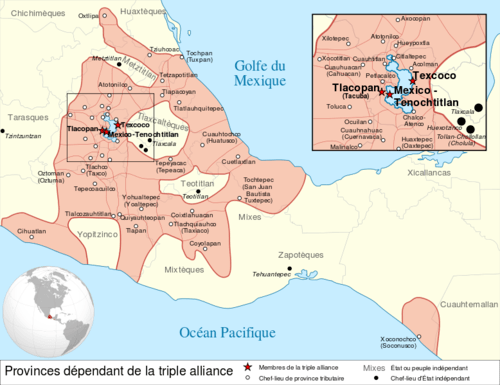The Aztecs ruled most of modern Mexico during the era of the Spanish Conquistadors. Their culture came to an end when Hernan Cortes, along with his allies, defeated the Aztecs. Unfortunately, much of what students study about Aztec History involves their fall and not their ascension into power. The Aztecs were a central power in the region for over a century before the Spanish arrived.

Jump to:
Aztec History: Table of Contents
| Aztec Empire | Aztec Timeline |
| Aztec Religion | Aztec Family Life |
| Aztec Food | Aztec Art |
| Aztec Jewelry | Calendar Stone |
| Aztec Clothing | Aztec Temples |
| Aztec Language | Aztec Culture |
| Aztec Games | Aztec Government |
| Aztec Weapons | Aztec Warriors |
| Aztec Map | Aztec Rulers |
Aztec History: Arrival in Mexico
The Aztecs were known as the Mexica and arrived in the Valley of Mexico in approximately 1248. They first settled in Chapultepec, which was near Lake Texcoco.
There were numerous city-states that already existed, many more powerful than the Mexica. In those early days, they were forced off of their original location and given permission to settle the empty barrens of Tizaapan in 1299. Over time, the original Mexica blended into the Culhuacan culture.
In 1323, the Mexica asked the new ruler of the Culhuacan for his daughter. They said they wanted to make his daughter their goddess, but unknown to the king, they planned to sacrifice her. They believed that by sacrificing her, the princess would join the gods as a deity. After sacrificing her, they flayed her skin, and a priest wore it at a festival dinner. The king of the Culhuacan saw what the Mexica had done to his daughter and was horrified and expelled them from his lands.
In 1325, after they fled, they went to a small island on the west side of Lake Texcoco, where they began to build their city, Tenochtitlan. This city would eventually become their capital and one of the wonders of the New World.
In 1376, the Mexica elected their first ruler, Acamapichtli
Aztec History: Rise of the Empire

Over time, the Mexica established a Triple Alliance. The Triple Alliance of Tenochtitlan, Texcoco, and Tlacopan would, in the next 100 years, come to dominate and extend its power to both the Gulf of Mexico and the Pacific shores. From the beginning of the Triple Alliance, Tenochtitlan was mostly in charge of the military and conquest, whereas the other two cities had other responsibilities.
Over multiple generations, the Aztecs began to increase their power. Within the Triple Alliance, Tenochtitlan became the dominant military power and continuously expanded its borders.
By the time Cortes arrived, Montezuma II was in his later years as a ruler and had successfully expanded the Aztec Empire. His campaigns reached as far south as Tapachula in the Soconusco region and the Chontal Maya states of Xicallanco in Tabasco. Only the Aztec archenemies of Tlaxcala, Huexotzinco, and the Purépecha remained undefeated, as well as the Mixtec kingdoms of Tututepec and Yopitzinco, which didn't interest the Aztecs.
This expanded the power of the Aztecs. However, it also created more enemies. As quickly as the empire rose, it would fall even quicker.
Hernan Cortes arrived in Mexico in 1519. The Aztecs believed him to be linked to the return of an exiled god, Quetzalcoatl, who was supposed to return pale and bearded.
Aztec History: Fall of the Empire
With the arrival of the Europeans came the arrival of European warfare and disease into Mexico.
Hernan Cortes' first attempt to destroy the empire ended with the death of Montezuma, and he and all of his men were almost captured. His conquest almost ended months after it had started. However, Cortes and his men had done much more harm to the Aztecs than they realized.
Within months after Cortes and his men escaped with their lives, the Aztecs were being decimated by European disease. Their entire population seemed to be affected. It was during this time that Cortes implemented another tactic that the Aztecs were not used to: the siege.
Cortes had allied himself with other native tribes that hated the Aztecs and he and his men had the superior weapons. He used his weapons and allies to advantage and put the city of Tenochtitlan under siege. Within months, the Aztecs were ravaged by disease and were starving.
The Aztecs were defeated, and within a few short years, the most powerful empire in Mexico vanished.
